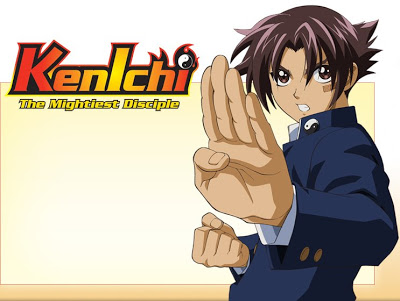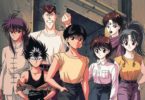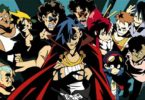If ever there were a quintessential Millennial-centric anime, its name would be Shijō Saikyō no Deshi Kenichi (The Mightiest Disciple Kenichi, 2006–2007). Based on author Syun Matsuena’s original work History’s Strongest Disciple Ken’ichi, the television adaptation Kenichi: The Mightiest Disciple (as it has been marketed stateside) illustrates the collective strengths and weaknesses of the Millennial Generation via the personal struggles of a teenage boy as he braves the trials of adolescence.
Apart from being genuinely entertaining through its overt use of hyperbole and general slapstick antics, Kenichi effectively reconciles much of the angst between today’s youth and preceding cohorts concerning Millennials’ purported disillusionment with the real world. By centering the plot around a protagonist whose optimism is dampened over and over again, and in turn surrounding him with instructors who repeatedly remind him of his lack of aptitude for the martial arts, the series’ staff writers and directors cast the plight of Generation Y in a light that is neither flattering nor unjustly belittling (after all, the folly of youth is certainly not exclusive to any one generation). This can be observed throughout the series as a continuous give and take, accentuating the good while acknowledging the bad: Kenichi Shirahama genuinely wants to better himself, but he initially underestimates the commitment and hard work it will take; he whines, complains and outright quits more than once, but he always ends up getting back onto his proverbial horse (even if he needs prodding sometimes); he needs a ridiculously large amount of support from others—an accommodating family, friends at school and not one but six martial arts instructors—but he takes full advantage of his assets by diligently applying what he learns and delivering when it counts.
Simply put, Kenichi more or less takes the middle ground between the now-evident advantages and disadvantages to the everyone-is-a-winner parenting model, the often-criticized overuse (or misuse) of positive reinforcement, and the sheltering of one’s children, physically and mentally, from the realities of adulthood. Overall, however, it seems to lean in favor of the young insofar as it presents any generational weaknesses as an inevitable tradeoff for different strengths, symbolized mostly by Kenichi himself: though hard-working, Kenichi often succumbs to self-apathy (again, as any young person does at times), seeking ways out of training rather than improving his skills; yet he possesses enormous amounts of empathy (as evidenced in episode 28 when he risked his own well-being to protect his ‘frenemy’ Nijima), especially when it concerns someone he cares about (such as when his younger sister Honoka is kidnapped in episode 32). From a cynical view, these traits are obvious given the source material’s Shōnen demographic, invoking adulation for a selfless do-gooder (an aspect of Kenichi loathed by his opponents) and titillating the source of revenue for the series itself, i.e. the teenage (male) viewers with a ‘feel good’ view of themselves. While profit margins are an unavoidable reality from a business standpoint, and the show—following its parent material—undeniably seeks to garner the attention of its target audience (whether it be artwork, character design or any of the numerous voyeuristic camera angles, females and their anatomy are considerably objectified), perhaps akin to the masters of Ryozanpaku themselves, the production crew sincerely wished to pass on their wisdom to their eventual successors.
Dubbed into English shortly after its initial release, Kenichi: The Mightiest Disciple is also an excellent example of quality ADR directing and voice acting on the part of its North American distributor. Josh Grelle delivers an outstanding performance as Kenichi Shirahama, while Kent Williams’ vocal nuances reserved for strong and intelligent characters fit the calm and dignified demeanor of Akisame-sensei perfectly. (A shame that, as of yet, there is no English dub of the 2014 follow-up OVA.)
In summation, to reiterate Kenichi was without a doubt cast from the same mold as its Shōnen siblings; yet unlike the fist-waving, hard-headed protagonists of many other works, Kenichi himself is actually relatable to his target audience as he struggles, complains, and even gives up multiple times during his quest (fortunately, he has teachers who will literally not allow him to altogether quit, a commentary on the dedication required of mentors for their pupils). What’s more, Kenichi’s quest is not for a specific relic, object or title: his is an inner journey, one which has no marked beginning or end. Finally, unlike his catchphrase-wielding contemporaries, Kenichi has no special ability or natural aptitude (at least, none that he is aware of) but perseveres all the same and is thus an appropriate role model for adolescents. Kenichi: The Mightiest Disciple is fantastic and fun for escapism-craving youth while at the same time being grounded in some level of reality—be it metaphorical or literal, as the martial arts Kenichi learns crisscross both territories (and include their own implicit and explicit takeaways)—to prepare said youthful viewers for their own battles.
Call it cliché if you must, but the highly adaptable themes of self-betterment and applying one’s life-accumulated knowledge eclectically to solve problems as found in Kenichi: The Mightiest Disciple are skill sets that anyone of any generation desperately needs, as are the stepping stones of adversity for growing up and gaining confidence along the way.
© 2015
Originally posted here.







